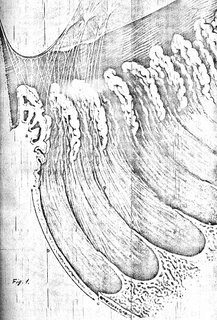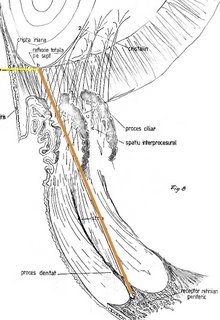Copyright © 2006 danwaniek.org
We report here a simple observation to support our functional model : a spatial correspondence between :
(a) radial transparencies in iridial structure,
(b) circular sectors in iridological charts,
(c) inter-processural spaces ( the ciliary valleys ) and
(d) processi dentati,
does indeed exist ( Fig. 3 ).

Fig. 3 : A novel observation concerning the anterior pole's peripherally aligned ( APPA ) vertebrate ocular structures : The spatial correspondence between the radial ( meridional ) structural elements of the iris, the lens and the peripheral retina, as they are viewed from the interior of the eye ( left ) and in medio-sagittal section ( right ) is put into evidence and more diagrammatically shown. There are radial transparencies ( 1 ) and stromal crypts ( 2 ) in the stroma of the iris, and these structures are in a good alignment with the ciliary valleys ( the free space between two adjacent processi ciliares ( 3 ) in pars plicata ). This alignment is shown further in pars plana, where the dentate processi of the retina ( 4 ) protrude along the symmetry axes provided by the striae ( which are not shown ). Light is permitted to reach the processi dentati along this path, considering that total reflection takes place on the anterior surface of the lens and its inter-strata. Only the inferior half of the lens is figured in the left panel. The dots at left stress the repetitive functional unit described here.
Copyright © 1986-2006 danwaniek.org ( Digimarc creator ID 10-727074 ) and the Iris-Ward.com, Inc. Based on an illustration originally published by Churchill Livingstone, with permission. All Rights Reserved.


